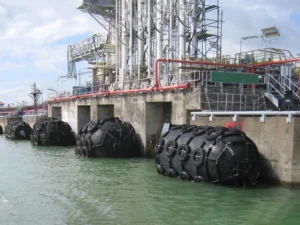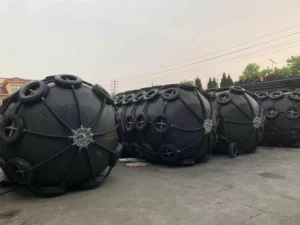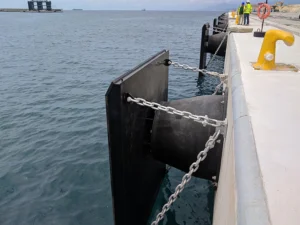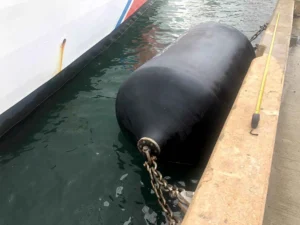Marine fenders help boats, ships and other naval vessels to avoid collision with each other and or against docks, wharves and piers. Another name used for them is marine bumpers; since boats can hit the port with brutal force while parking, marine fenders are compulsory equipment for naval transport.
There are numerous types of marine fenders serving different purposes depending on the nature and size of the vessel. However, their main goal is to prevent damage to the ship and the surface.
Rubber fenders are used at both ends of the ship, including the head and hull. Likewise, they are available on docks, piers and port structures. Moreover, if you have a boat and love going out in the water, you must consider having ship fenders for smooth stoppages.
We will introduce different types of marine fenders in this article.
So, let us get started!
Different Types of Marine Fenders
Marine fenders come in different sizes and purposes; therefore, if you are looking for one, here are the key types and their uses.
Broadly speaking, there are three main categories of pneumatic fenders.
- Pneumatic fenders
- Marine rubber fenders
- Foam filled fenders
-
Pneumatic Fenders

A fender with the shape of a cylinder covered in tires and attached to the main structure with a chain is the pneumatic fender. These are generally connected via chains and ropes and float freely next to the dock.
Since these are free, they are a perfect fit for uneven tidal shores. Likewise, pneumatic fenders are easy to deploy, making them the right choice for emergencies.
Moreover, they serve STS operations, where the transfer of goods takes place from one ship to another mid-sea. Their free movement makes them ideal apparatus for this type of operation.
In addition, these require low maintenance cost, and possess soft reaction force. Generally, captains love to fit tyres and chains on pneumatic fenders for extra protection.
Types of Pneumatic Fenders
Pneumatic fenders have three main types.
-
Yokohama pneumatic fenders:
One of the oldest and most trustworthy pneumatic fenders that is ideal for LPG vessels, ocean platforms and large docks. Likewise, their durability makes them the best investment as it provides outstanding return on investment.
Moreover, this type of pneumatic fender can evenly distribute load and stress. In addition, a safety valve offers an added precaution against accidents.
-
Sling pneumatic fenders:
It is a type of fender that comes without a netting. These have a double-layered cover, resulting in better resistance to operational damages. These are easy to carry and install, thus making them perfect for small to medium sized boats.
-
Hydro pneumatic fenders:
A fender that is partially filled with water and air. These are used for submarines to ensure submerged hulls are properly protected. Since these types of vessels require waterline solutions, hydro pneumatic becomes ideal. Moreover, these provide unique services like sub-surface contact face, variable drift and low hull pressures.
Pneumatic Fender Characteristics

Pneumatic fenders have numerous distinguishing characteristics, including the following.
- Cone fender has a height range of 500 and 9000 mm
- Proportional increase of energy and reaction
- Low hull pressure
- Easily de-inflatable
- Easy storage
Applications
- Temporary berthing
- Oil and gas facilities
- Ship-to-ship (STS) lightering operations
- For ports with extreme tidal variations
-
Marine Rubber Fenders
As the name suggests, rubber fenders primarily come in rubbers. Rubbers are waterproof and absorb collision powers, thus making them ideal fenders for smooth berthing.
Considering their heavy workload, they are ideal for LNG, offshore terminal, oil and container berths. Since these are designed to make serious shifts; hence, they are highly sturdy and durable.
Moreover, its design supports resistance and sturdiness.
Another key feature of rubber fenders is that they can absorb energy in equal levels from different compact structures. If you are looking for a fender that can stand sheer force, a cell fender is your product.
Types of Marine Rubber Fenders
The following are different types of marine rubber fenders.
-
Cell fenders:
As the name suggests, cell fenders come in the shape of a cylinder. These are one of the best in class fenders that offer the highest energy absorption to weight ratio. Moreover, their versatile utility makes them ideal fenders for medium to large sized vessels.
Cell fenders can support large panels, offer high performance and are ideal for low hull pressure systems.
-
Cone fenders:

Cone fenders have a cone shape and offer support to remain stable during heavy impact angles from large ships. Moreover, their form allows them to last longer than cell fenders.
Further, the cone fender is an improved version of a cell fender. The cone design helps this type of fender to withstand high-altitude tidal variations. Likewise, these are equally a handful in enhancing vessel crane’s material handling capabilities. In addition, cone fenders are famous for managing heavy vessels.
-
Arch fenders:
These fenders perfectly fit for tight or limited spaces, as their design and shape allow them to fit in such places where no other fender can operate. Moreover, these have one whole shape with either side attached to the surface (horizontally or vertically). Likewise, their design allows them to cushion high impact levels without suffering any damage.
Although arch fenders are the smallest in size, they can manage heavy workloads and are incredibly reliable. Moreover, these are highly customizable and offer excellent vessel protection during mooring conditions.
-
Cylindrical rubber fenders:
These were the first fenders produced and have developed over time to their current shape and usage. They offer simple installation, and excellent force absorption.
Moreover, these have different sizes, and support softer berthing.
-
D Fenders:
D fenders are cost-effective and durable. Their shape makes them a perfect fit for smaller wharves and quays. Moreover, mariners can utilize these for tugboats, fishing vessels and small boats.
Marine Rubber Fenders Characteristics
Rubber fenders have the following distinguishing characteristics.
- Cell fender has a height range of 400 and 3000 mm
- Easy to assemble and install
- Excellent sheer force resistance
- Robust
- Cost-efficient
Applicability
Cell fenders are a perfect fit for the following purposes.
- Bulk terminals
- Large sized containers
- Oil and gas terminals
- Cruise terminals
- Navy
- Ferry and RoRo terminals
-
Foam Filled Fenders

Foam fenders come in a two or four-layered structure. The inner core has polyethylene while it has a covering of reinforced polyurethane elastomer. The water penetration to these parts is nil.
Likewise, these are durable and easily repairable.
Types of Foam Filled Fenders
Foam fenders have the following types.
- Portable Foam Fender
- Sea-cushion fenders
- Donut fenders
- Composite fenders
- Tug fenders
Foam Fenders Characteristics
Foam filled fenders have the following key characteristics.
- High energy absorption/low reaction force
- Unsinkable
- Low maintenance costs
- Easy installation
- Cost-effective
Applicability
Foam filled fenders are ideal for following purposes.
- STS operations
- Stormy conditions
- Navy
Marine Fenders Buying Guide
Buying marine fenders is a daunting task, as there are so many different types. However, certain consideration points remain valid and should be checked before purchasing any marine fender.
- Look for a fender that has high-quality material for excellent performance
- A Fender that requires minimum maintenance cost is always a better option
- Determine your requirements and purchase the one that will satisfy your demands
- Opt for a marine fender that can withstand all types of weather conditions, including the harshest ones
- The type of marine fender that is durable, whether it costs a bit higher, is a better option than a cheaper one.
Choose the Right Fender at JerryBorg Marine!
Users need clarification while choosing the right fender that is worth spending. But, usually they end up buying the wrong size of the marine fender.
As there are many types of marine fenders, picking up the one that suits your boat is a critical decision. To make it hassle-free, JerryBorg Marine is your best choice for marine fender manufacturer..
So, if you are looking for a durable, sturdy and all-rounder fender, Jerryborg Marine has got your back. Here, you can get the right size and type of marine rubber fenders suitable for any weather condition.
Here is a simple guide for choosing the right size boat fender.
- Boat length under 10 feet – Fender diameter 3 inches – Small
- Boat length 10 to 15 feet – fender diameter 3 to 4 inches – Small
- Boat length 20 to 25 feet – fender diameter 6 to 6.5 inches – Medium
- Boat length 25 to 35 feet – fender diameter 8 to 8.5 inches – Medium
- Boat length 35 to 50 feet – fender diameter 10.5 to 12 inches – Large
- Boat length 60 to 72 feet – fender diameter 15 to 24 inches – Large
Parting Thoughts
Marine fenders are a necessity when it comes to maritime transport. They help vessels of all sizes to stop on shores or even help to shift equipment during STS (ship-to-ship) operations. There are different types of fenders for ships depending on their usage and material of production.
Famous types of marine fenders include rubber fenders, pneumatic fenders, d rubber fenders, cone fenders and cell fenders. Moreover, the navigational fender system is one of the most vital parts of the boating system.
So, if you are looking for a fender that is durable, sturdy and can work under any environmental conditions, Jerryborg Marine has got your back. You can get the right size and type of fender in the comfort of your home.
At Jerryborg Marine, we ensure you get the right fender for your boat. So, let us absorb all the force of the ship while you enjoy your ride.
